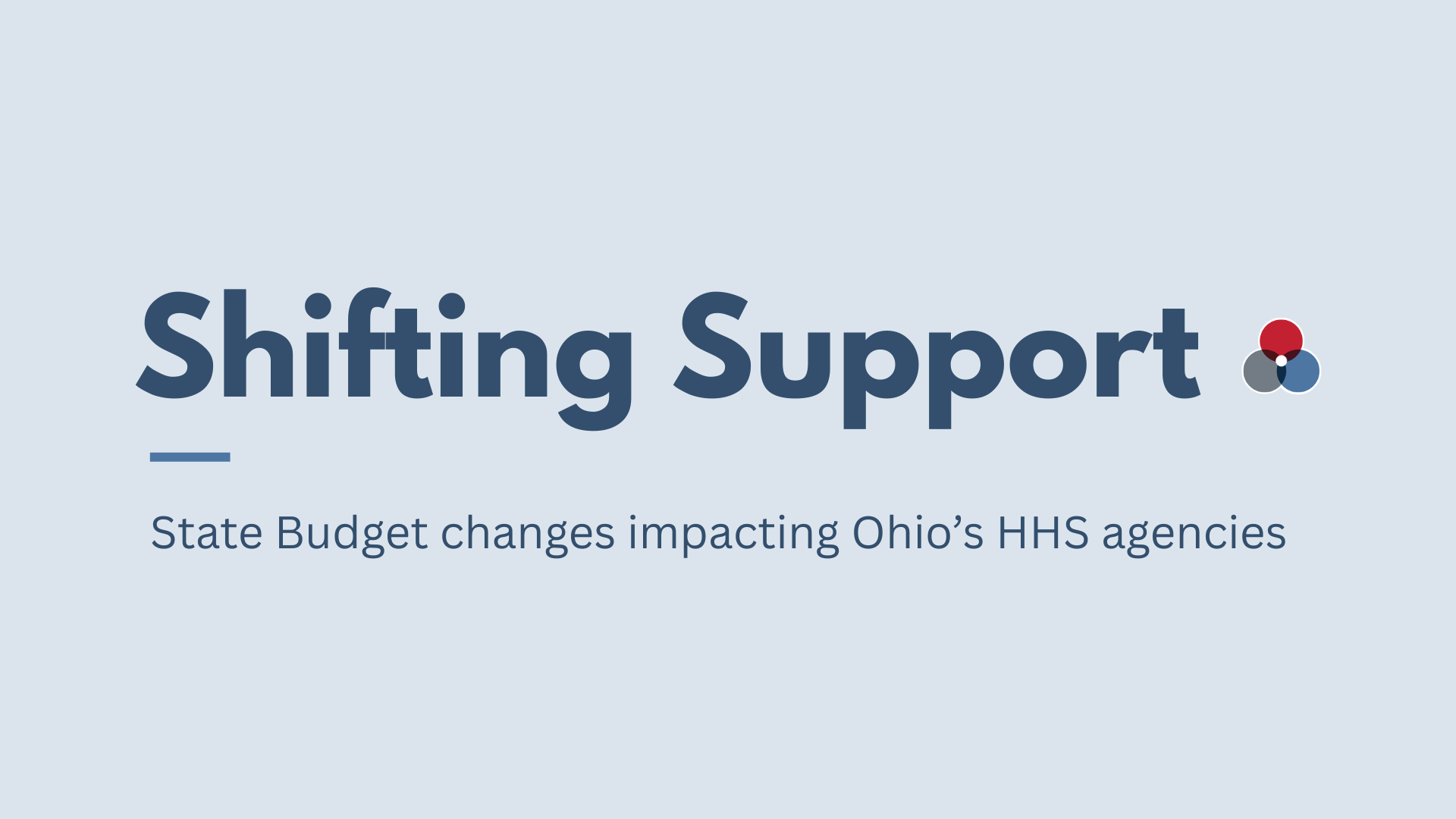What is EBT?

Electronic Benefit Transfer (EBT) is the nationwide payment system used for two major food assistance programs – the Supplemental Nutrition Assistance Program (SNAP) and Pandemic-EBT (P-EBT).[1] Families eligible for food assistance through these programs receive food-only funds on a debit-like card, called an EBT card, to purchase groceries at any participating food retailer. In Ohio, SNAP’s EBT card is also called the Ohio Direction card.

The EBT system replaced paper coupons (called “food stamps”) in Ohio in 1999 and is the responsibility of the Ohio Department of Job and Family Services (ODJFS).[2] EBT technology is widely considered responsible for SNAP’s impressive track record on delivery efficiency and payment integrity.[3] The EBT system is complex and includes many components, such as:
- Payment interfaces with SNAP retailers
- Manufacturing and mailing of EBT cards
- EBT transaction monitoring and fraud detection
- EBT customer service, such as EBT hotline and online portal management Because of the complexity of states’ EBT systems and their interconnectedness to retail payment systems, all states contract with private-sector vendors to manage most or all of these responsibilities under the direction of the state’s SNAP agency.[4] Ohio’s current EBT vendor is Conduent, which took over the state’s EBT contract from JPMorgan Chase in 2014. Ohio is expected to begin a new procurement process for an EBT vendor this year.
Ohio is expected to begin a new procurement process for an EBT vendor this year.
The COVID-19 pandemic revealed the strength of SNAP’s EBT systems to respond quickly to changing circumstances, including a sudden spike in need, ensuring eligible families continued to have access to food assistance benefits. However, the pandemic also revealed weaknesses in some aspects of state-EBT systems, especially customer service. This paper presents a case study on efforts by Ohio advocates in 2020 to respond to identified problems with EBT’s customer service, some of which pre-dated the pandemic, to ensure that ODJFS makes responsiveness to SNAP recipients’ needs a top priority for EBT vendors serving the state. The Center for Community Solutions (Community Solutions) and its advocacy partners are hopeful that ODJFS will incorporate these recommendations in its re-procurement process for Ohio’s EBT system in the near future.
EBT customer service issues
The Benefits Access Partnership is a collaborative effort between Community Solutions, the Cuyahoga County Department of Job and Family Services (CJFS), the Greater Cleveland Food Bank (Food Bank), and the Legal Aid Society of Cleveland (Legal Aid) to improve access to public benefits in Cuyahoga County, with a focus on SNAP.
In 2020, the Benefits Access Partnership (BAP) identified Ohio’s EBT customer service line as a common source of frustration and confusion for SNAP recipients.
In 2020, the Benefits Access Partnership (BAP) identified Ohio’s EBT customer service line as a common source of frustration and confusion for SNAP recipients who struggled to access the food benefits they had been approved to receive. After getting many referrals from the Food Bank, Legal Aid took the lead in investigating EBT complaints and traced them back to several policies and practices in place in Ohio:
- Excessive delays receiving EBT cards When the pandemic began in March 2020, demand for SNAP benefits spiked and a new federal program for school children (called Pandemic-EBT) was created. Both of these things put extraordinary pressure on EBT processors to quickly ramp up the production and distribution of EBT cards. Card delays during this time compounded the existing concerns advocates held about the untimely delivery of EBT cards to eligible customers.
Even before the pandemic began, SNAP recipients frequently reported not receiving their EBT card in the mail within federally mandated timeframes.[5] As soon as a household’s SNAP application is approved (which can take up to 30 calendar days), SNAP benefits are issued to an EBT card. If the head of household has not received SNAP benefits in the past, a new EBT card is created and mailed to the household. Unlike some other states, Ohio does not permit EBT cards to be issued in-person at JFS offices, even for homeless individuals or others without a reliable mailing address.[6] The card mailing process can take an additional seven to 10 business days, not accounting for any postal service delays. This often means that newly-enrolled households are waiting an additional two weeks (and sometimes more) beyond federal standards for when SNAP benefits should be available for the household to use.[7]
Because of Ohio’s all-mail EBT issuance system, in many cases the state is out of compliance with federal timeliness standards for households that are eligible for expedited processing.
Similarly, because of Ohio’s all-mail EBT issuance system, in many cases the state is out of compliance with federal timeliness standards for households that are eligible for expedited processing. (Expedited processing is reserved for those without any income available to purchase food.) Anytime the EBT card arrives more than seven calendar days from the date of application (except in cases of delayed discovery of expedited eligibility), Ohio is out of compliance with federal standards. ODJFS has the ability to speed up card delivery in extenuating circumstances, but this is expensive under Ohio’s current EBT contract and rarely used.[8] County JFS offices do not have the authority to expedite EBT cards at their own discretion.
Long delays in receiving an EBT card appears to also extend to SNAP recipients who need to request a replacement EBT card. In a survey of SNAP recipients in Ohio who use the FreshEBT app, 64 percent reported that “It took a long time to receive a replacement card once I ordered it.” By comparison, only 29 percent of FreshEBT users in Wisconsin reported the same challenge.[9]
- Confusing EBT customer service prompts for households without an EBT card
Ohio’s EBT vendor is responsible for operating the state’s EBT Customer Service Center, which is a call center for SNAP recipients to complete a variety of EBT-related requests. Through an Interactive Voice Response (IVR) system, SNAP recipients can activate their EBT cards, check the card balance, and perform other related functions, as long as the SNAP caller knows their EBT card number.
Unfortunately, the automated prompts are incredibly confusing for families to navigate. For example, when prompted to enter the PIN number, the caller needs to know to “press nothing” in response to two separate prompts if they do not have a PIN (and the automated system does not say “press nothing” it just says “enter your four-digit PIN number.”) SNAP recipients frequently seek assistance from community-based organizations, including food banks and Legal Aid Societies, along with County Departments of Job and Family Services. In fact, 26 percent of SNAP recipients in Ohio surveyed by the FreshEBT app in April 2021 reported calling their caseworker when they had questions about their EBT card.[10] However, County JFS offices are not authorized to request new cards for households. This can result in significant frustration for families, along with wasted time for County JFS employees that could have been spent on more productive tasks.
- Difficulty reaching Ohio’s EBT Customer Service Center
The primary function of the EBT Customer Service Center that does require speaking to a live customer service representative is reporting an EBT card lost or stolen (which includes cards that simply never arrived after initial benefit approval). According to the Food Bank, SNAP recipients regularly reported long wait times to reach EBT customer service representatives even before the pandemic began. ODJFS data shows that wait times spiked in the early months of the pandemic and remained high through at least September 2020.[11] By December 2020, data suggest that wait times to reach EBT customer service had improved, although some customers still experience longer than acceptable wait times.
SNAP recipients regularly reported long wait times to reach EBT customer service representatives even before the pandemic began.
- Problematic online portal for EBT card management
Ohio’s current EBT vendor provides SNAP recipients an online alternative to the Customer Service Center called the EBT Customer Service Portal. Through the portal, users can create EBT accounts, review their EBT account balances and transaction history, and reset their PIN numbers. Ideally, accessing information through the portal should be as simple as checking your bank account online. However, during 2020 when many SNAP recipients faced delays in receiving newly issued or replacement cards, the EBT online portal proved problematic as well. SNAP recipients could not create an EBT account without their EBT PIN number. Therefore, those waiting for EBT cards or needing replacement cards and those without access to computers, were left with no option but to wait to speak to a customer service representative over the phone.
Survey data reinforce client reports that the online EBT portal is difficult to use. Less than 4 percent of FreshEBT users in Ohio reported ordering a replacement card through the EBT website, compared to 94 percent who ordered a replacement card through the 1-800 number (i.e. the Customer Service Center).
- Policy of issuing new SNAP benefits to previously inactive EBT cards
Because some SNAP recipients have received benefits in the past and may already have EBT cards, Ohio’s policy is to reissue benefits to the original card in all circumstances. If the household no longer has the old EBT card, they must request one through the EBT Customer Service Center. Ohio’s SNAP application does not ask whether the household has an old EBT card or would like new benefits to be issued to that card. Unfortunately, many SNAP recipients no longer have the old card and do not realize that they must proactively request a new card if they previously received benefits. This can result in customers waiting weeks, or even months, for a card to arrive in the mail that was never generated and sent by the EBT vendor.
In July 2020, Legal Aid sent a letter to ODJFS detailing these concerns and requested a meeting for further discussion. ODJFS was responsive to these concerns and took action to resolve individual cases. To address the systemic issues raised by Legal Aid, ODJFS agreed to review current policies and practices and tackle vendor-specific changes to the state’s upcoming EBT contract re-procurement, expected to begin later this year. Throughout these conversations, ODJFS remained open to recommendations from advocates on how to improve Ohio’s EBT system to better serve customers.
Recommendations to improve EBT customer service
On October 30, 2020, the Benefits Access Partnership submitted recommendations to the Ohio Department of Job and Family Services on how to improve the customer service experience for Ohio’s EBT customers. These recommendations were informed by the direct experience of SNAP recipients, along with the dedicated staff at the Food Bank, Legal Aid, and Cuyahoga JFS who assist these families every day.
- Hold EBT vendors accountable for customer service standardsThe Ohio Department of Job and Family Services should:
- Closely monitor the performance of Ohio’s EBT vendor and include corrective action planning and explicit penalties if the vendor consistently fails to meet performance standards for responsiveness.
- Require the EBT vendor to offer a virtual hold (i.e. automatic call-back) option for periods of unexpectedly high call volume, such as a sudden increase in SNAP enrollments.
- Increase monitoring on the EBT Customer Service Center (e.g. listen to a reasonable percentage of calls per quarter) and create clear escalation procedures for reporting customer service representatives who provide poor customer service (e.g. treat SNAP recipients disrespectfully).
- Improve EBT card issuance and mailing processesThe Ohio Department of Job and Family Services should:
- Proactively ask every SNAP applicant – on the application and during the initial interview – whether they already have an EBT card.
* If Yes, indicate in the Ohio Benefits Worker Portal (the SNAP eligibility system), that no new card needs to be generated. For these customers, SNAP benefits issued by day seven (for expedited cases) or day 30 (for non-expedited cases) can be considered timely.
* If No, indicate in the Ohio Benefits Worker Portal that a new EBT card must be generated and mailed for arrival on day seven (for expedited cases) or day 30 (for non-expedited cases). If the eligibility decision is made too close to the deadline (e.g. on Day 29 for a non-expedited case) for the EBT card to arrive on time using first-class mail, ODJFS should automatically authorize the overnight shipping of the EBT card to ensure timely receipt of benefits. - In the long term, consider ways to incentivize counties to process benefits closer to the date of application, through methods like same-day screening for expedited eligibility and/or other business process re-engineering strategies, to avoid the need for overnight card delivery.
- For accountability, publish timeliness information by county showing the number of days between application, determination (i.e. approval/denial), and card issuance.
- Revise EBT card replacement processThe Ohio Department of Job and Family Services should:
- Require the EBT vendor to make changes to the Interactive Voice Response (IVR) prompts to better serve customers. One key change needed is to specifically include a prompt for applicants who have not received their EBT cards which directly connects them to a customer service representative.
- Allow CJFS workers to request a replacement card:
* At the time of application, after affirmatively asking whether the applicant currently has an EBT card.
* When contacted by a current SNAP recipient who has been unable to successfully request a replacement card on their own. - Study the possibility of automatically issuing a new card to SNAP recipients who have not had an active SNAP case for a significant period of time (e.g. three to five years). BAP partners supported several households who have not received SNAP in 10 or more years and discovered benefits had been issued to their old EBT cards only after months of waiting for new cards to arrive in the mail.
Conclusion
With the upcoming re-procurement of Ohio’s EBT vendor contract, Ohio has a once-in-a-decade opportunity to ensure the state’s EBT system prioritizes customer service standards for the 765,000 households who receive SNAP benefits to help feed their families.[12] Furthermore, the Benefits Access Partnership is hopeful that its recommendations will result in stronger policies, procedures and oversight of Ohio’s EBT functions to better serve customers and comply with federal guidelines.
These recommendations may also be useful to SNAP advocates in other states who are similarly focused on improving their state’s EBT customer service standards.
These recommendations may also be useful to SNAP advocates in other states who are similarly focused on improving their state’s EBT customer service standards. Advocates outside Ohio can find details on when their state is likely to go through their own EBT contract re-procurement process here: EBT Status Report by State, March 2021.
[1] See https://www.fns.usda.gov/snap/ebt. The Special Supplemental Nutrition Program for Women, Infants, and Children (WIC) also uses EBT technology but operates separately from SNAP and P-EBT.
[2] See https://codes.ohio.gov/ohio-administrative-code/rule-5101:4-1-04
[3] See https://www.fns.usda.gov/snap/short-history-snap#1988
[4] See https://fns-prod.azureedge.net/sites/default/files/resource-files/ebt-status-report-state.pdf
[5] See 7 CFR 274.2(b)
[6] Examples of states who provide in-office card issuances in some circumstances: Colorado, Maryland, Massachusetts, and Pennsylvania.
[7] See 7 CFR 274.2(b)
[8] Accessed through a public records request submitted by the Center for Community Solutions on September 20, 2020
[9] FreshEBT is a free financial services app by Propel for SNAP recipients to manage their benefits. Survey data presented here is based on self-reported information from 284 anonymized surveys. The survey was made available through FreshEBT to randomly selected individuals who opened the app between April 1-April 15, 2021.
[10] Ibid.
[11] Accessed through a public records request submitted by the Legal Aid Society of Cleveland on November 24, 2020 and January 21, 2021
[12] See https://jfs.ohio.gov/pams/Caseload-Summary-Report-February-2021.stm


.png)





